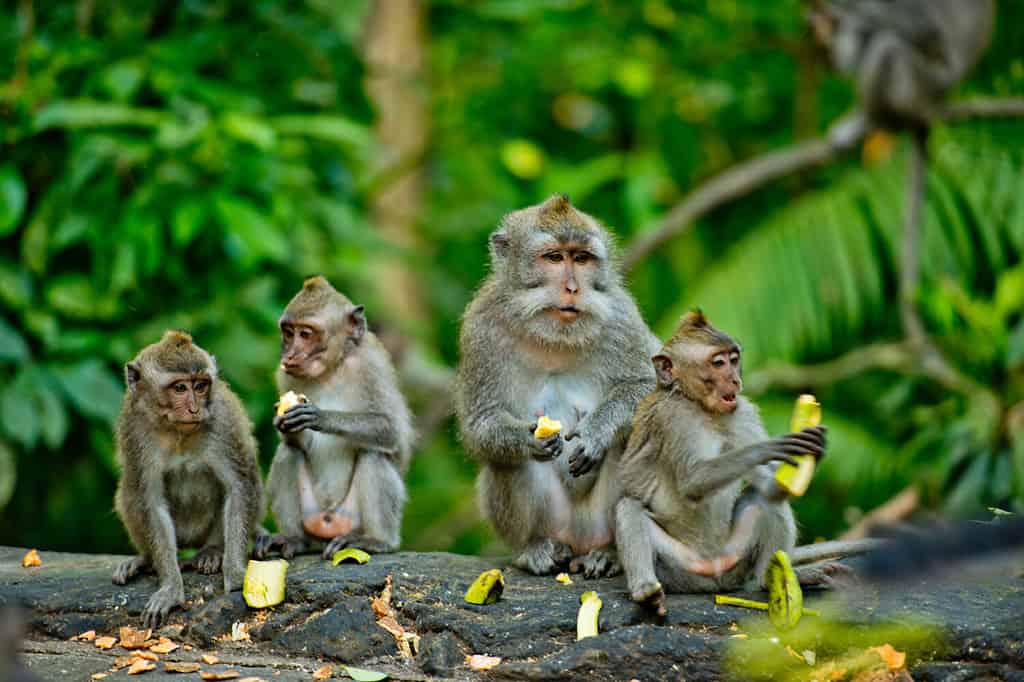We use countless idioms in everyday conversations, often without even realizing we’re doing it. Many of these sayings come from different cultures, company slogans, or even religions. Additionally, it’s common for idioms to reference animals (think: “canary in a coal mine” and “raining cats and dogs.”) You’ve likely heard of the phrase “monkey see, monkey do,” but do you know where it originated?
Many people say “monkey see, monkey do” to describe mimicry. This is because monkeys are commonly known to imitate other monkeys and even humans. Here’s the origin and meaning of “monkey see, monkey do,” as well as appropriate, real-life uses of the phrase.
Origins of “Monkey See, Monkey Do”
While no concrete evidence exists, most people believe the saying “monkey see, monkey do” originated in Jamaica during the early 18th century. Eventually, during the 1920s, the phrase made its way to America. It’s said to have stemmed from a form of pidgin language or a “grammatically simplified communication method that develops between two or more groups.” Otherwise, the correct grammar would be “Monkey sees, monkey does.”
Today, we use the phrase “monkey say, monkey do” to reference someone mimicking another’s actions — often without understanding why they’re doing it. Because monkeys are smart and tend to imitate each other or humans, this idiom is the perfect way to label the action.

It’s common for monkeys to mimic each other and humans.
©Leo_nik/Shutterstock.com
Meaning of “Monkey Say, Monkey Do”
As noted above, “monkey say, monkey do” describes the action of imitating someone else. Sometimes, this is without awareness or concern for the consequences. Other times, it’s instinctual or for good reason. Regardless of the motivation, copying another’s actions or processes occurs commonly in everyday life.
The saying is also commonly used to describe children who will learn from their parents’ behavior and imitate what they do. Of course, at that young age, they lack the proper understanding of the behavior and simply mimic their parents as a form of curiosity or desire to learn.
The Psychology Behind “Monkey See, Monkey Do”
The psychology behind the notion of “monkey see, monkey do” can be explained through the Bobo Doll Experiment. Psychologist Albert Bandura conducted this controlled experiment to determine whether children are able to learn by observing their parents’ (or other adults’) social behaviors. In this case, researchers specifically studied aggression.
During the experiment, researchers physically and verbally abused an inflatable doll in front of a group of young children (ages three to six). In the end, the group of kids who witnessed the aggression were far more aggressive than children in the control or non-aggressive groups.
This experiment proved that children pick up social behavior (monkey do) through observational learning (monkey see).
Other studies focused on monkeys and their observational patterns, finding evidence that groups of monkeys imitate each other as a form of communication or when traveling, feeding, or defending themselves. Additionally, they will often imitate humans, including different facial expressions. Much of this imitation likely stems from curiosity and affection.

Children learn from adults, often by mimicking their actions.
©Rawpixel.com/Shutterstock.com
Examples of Everyday Use
You can use “monkey say, monkey do” in many situations. Here are a few real-life examples of the idiom in action.
- You’re babysitting your niece, allowing her to help you bake cookies for a cozy movie night together. As you’re dancing around the kitchen to Fleetwood Mac, you stub your toe on the edge of the cabinet. Without thinking — and before you can stop yourself — you mutter a curse word. Immediately, your niece falls into a fit of giggles and starts repeating the curse word over and over. Monkey see, monkey do!
- You’re at a family party and have already finished dinner. The table is cleared, dishes are clean, and loved ones are gathering around chatting. You’re sitting with your cousins next to the dessert table, and one of them asks whether you think it’s time to break out the sweets. You shrug, stand up, and serve yourself — why wait? After, everyone seems to follow suit, helping themselves to the assorted baked goods. Monkey see, monkey do!
- A content creator constantly produces the same type of videos as another creator without ever sharing something creative or original. Rather than brainstorming their own topics or ideas, they’ll just follow trends or copy other users. Many will deem this behavior as a form of “monkey see, monkey do.”
We might also use this idiom to reference issues like peer pressure. For example, many reference the “monkey see, monkey do” mentality when teenagers give into the peer pressure to drink or experiment with drugs simply because everyone around them is doing it.
What Is a Useful Way to Illustrate the Phrase “Monkey See, Monkey Do?”
No one wants to be viewed as a copycat. If you notice that someone has been imitating you or another person, you can lightly joke with them by using this idiom. It might help call out their behavior and encourage them to embrace their own authenticity.

Monkeys are extremely smart animals, which might be why they’re able to mimic humans.
©Nick Fox/Shutterstock.com
Another helpful use of this idiom is as a reminder to parents and other guardians to be careful what they do in front of their children. Many kids will pick up unhealthy habits, including negative self-talk or criticism from their parents. For example, if you’re constantly complaining about your appearance or body, this might cause children to develop similar negative opinions about their own bodies through learned behavior.
Additionally, many will use this idiom to express the dangers of mimicry. For example, if someone is constantly following another person’s actions, they might lack a sense of self and can get caught up in dangerous social situations. This can be due to curiosity, peer pressure, or even just the desire to appeal.
What Are the Possible Pros and Cons?
Using the phrase “monkey see, monkey” is a great way to refer to various situations involving imitation. This might be used as a joke to call someone a “copycat” or used as a way to flag any sort of negative mimicry exhibited by kids from their parents. However, there are some instances when you should steer clear of using the idiom altogether.
Here are the possible pros and cons of using the phrase “monkey see, monkey do”:
Pros:
- It can act as a playful way to point out someone who is imitating you or another person.
- It can be an endearing phrase used when a child imitates something innocent from their parents, such as helping clean the kitchen.
- It can remind adults to watch what they say or do around children.
Cons
- It’s often used as a sort of criticism for someone who is thought to have “copied” another person. This can come off as insensitive and unnecessarily judgmental. Sometimes, people imitate each other as a form of flattery, and it isn’t always a bad thing!
- It might make light of a situation that needs to be taken seriously, such as when someone is experimenting with drugs because others in their life have done the same. Using this phrase in this instance can come off as callous.
“Monkey See, Monkey Do” — Bottom Line
Many people frequently use this popular idiom to describe mimicry and reference children’s tendency to imitate their parents’ behavior. Backed by psychology, the phrase rings true in a variety of social situations. Next time you decide to use the phrase, remember its origin and ensure you’re being sensitive to any of its implications.
The photo featured at the top of this post is © Pakhnyushchy/Shutterstock.com
Thank you for reading! Have some feedback for us? Contact the AZ Animals editorial team.






